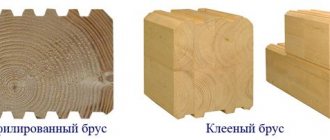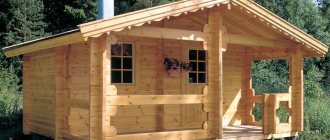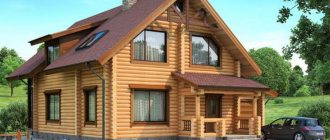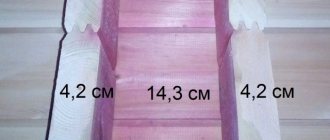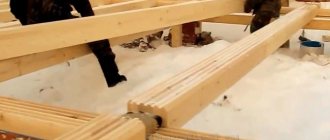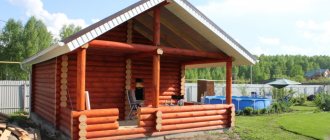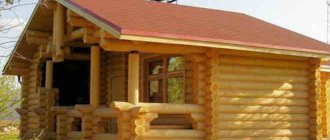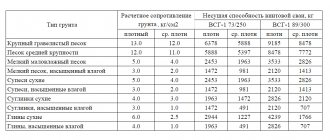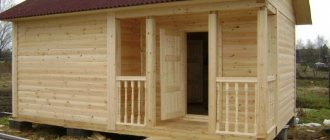A bathhouse measuring 6x4 meters is a common construction option: in a building of this size, one can distinguish a fairly spacious steam room, a dressing room, and a relaxation room. Before starting construction, you need to calculate how many cubes of timber will need to be purchased to build the walls of the structure. Let's consider detailed calculations for profiled timber with a section of 90x140, 140x140 mm without taking into account the profile. It should be borne in mind that the obtained value will in any case be approximate.
Simple calculation
It would seem, based on school knowledge, nothing is simpler. Having found out the length, height and width of a log or beam, you can simply multiply and get the result of the dimensions of a wooden box. However, the diameter of the material must not be overlooked; it directly affects the final figure and width of the compensation cut, which leaves the original size of the logs, but significantly reduces the amount of wood.
It becomes clear that calculating the volume of a log house is not a very simple matter, especially taking into account the methods of connecting the corners - with and without the remainder. But still feasible. So, we have the desired size 6×6 and using this example we will analyze the required quantity:
First of all, you need to understand that a larger diameter of logs will ultimately be a plus in the overall cost of money. After all, a built house will cost with a smaller layer of insulation, or even without it at all.
Thus, it becomes clear that construction must be carried out using logs with a diameter of 26 cm and above. So - the first known size is diameter = 0.26 mm.
Next, the height of the log house. It is impossible to calculate the frame for a house without taking into account the height. Usually it is 2.4 m per floor in the pure internal version.
But let’s take an external height of 3 m as the required quantity. Now it’s not difficult to calculate the logs for one wall - 3/0.26 = 11.5 pcs. Round up to 12 and add the base crown element. Total number of logs per wall = 13 pcs.
Now let's make calculations for all the walls of the log house. Let's take a five-wall structure as an example, since the lengths of the sides are the same, it is not difficult to calculate a log house by the number of logs - 13 × 5 = 65 pieces. That is, to build a 6x6 house with a log diameter of 26 cm, 65 logs will be required.
But the material is not purchased individually. For this there is such a measure as volume. Of course, you can go to a sawmill and point your finger at the logs to indicate what material is needed, but it will look more than strange.
Using the well-known school formula - π*R²*L, we find the volume of one log. Multiplying the data - where R is the radius of the deck, and L is the length, we get the result 0.32 m³.
It is now easy to calculate the cubic capacity of the entire log house - 0.32*65=20.8 m³. That is, for a 6x6 house, a one-story five-wall building, 3 m high, approximately 21 m³ of forest will be required.
Now, by assessing the offers on the market of lumber production companies, you can understand whether the average family can handle solid wood construction. The proposed option is a large house, even one floor high.
To this should be added the costs of the foundation, rafter system and finishing, which together can increase the project amount by more than 2 times. By the way, you can calculate a log house using the example given, and its cost is lower than a log.
Table of cubic capacity calculations for material of different diameters
To make complex calculations easier for users, here is a table of ready-made cubic capacity calculations for a certain array diameter:
| Log diameter | Log volume m³ at different lengths of logs |
3.0 3.5 4.0 4.5 5.0 5.5 6.0 6.5 20 0.107 0.126 0.147 0.170 0.190 0.210 0.230 0.260
22 0.130 0.154 0.178 0.200 0.230 0.250 0.280 0.310
24 0.157 0.184 0.210 0.240 0.270 0.300 0.330 0.360
26 0.185 0.210 0.250 0.280 0.320 0.350 0.390 0.430
28 0.220 0.250 0.290 0.330 0.370 0.410 0.450 0.490
It is important that everything that exceeds the presented length and volume should be left to specialists, because the construction of such logs cannot be done without the use of special equipment, and, therefore, it is much cheaper and faster to entrust the work to professionals by ordering a turnkey log house from the company. Before concluding a contract, you can ask the company manager how cubic capacity is calculated
Answering all the client’s questions is his sacred duty. Perhaps the knowledge gained will serve as support for independent construction of an object other than a residential building.
Assessment activities
In the process of calculations, you will have to understand how much 150x150 timber is needed for a 6x4 bathhouse, but in addition to the main material, you will need to make calculations of other parameters. This primarily concerns the foundation and roofing. As for the remaining points, they are of secondary importance (see also the article Projects of wooden baths: a review of ready-made solutions).
Calculation of a block base
Most often, during the construction of this structure, foundation blocks are used, which are laid in one row. Making calculations is quite simple if you know the volume of elements and the number of laying lines.
Basically, reinforced concrete products are installed in three stripes, which is often reflected in the installation instructions.
- The first step is to determine the height of the base, but this is done based on the standard thickness of the blocks so that there is an economic benefit. For example, for a 60 cm foundation you will need exactly three rows of 200 mm elements.
- After this, the area of the entire tape is calculated, and this is easy to do if you know the dimensions of the planned structure. Height is multiplied by length and width. Thus, it turns out: 0.6*4*2+0.6*6*2=12 sq. m.
- Next, the number of squares in one cubic meter is calculated. To do this, you need to know the thickness of the blocks used. In our case, the elements have a height of 20 cm, so it turns out: 1: 0.2 = 5 square meters. m.
- Now all that remains is to divide the total square footage of the foundation by the number obtained in the previous paragraph (by the number of squares in 1 cube). This leads to the following example: 12_5 = 2.4 m3.
A table to help you determine the laying depth.
Addition! The final price of the base is determined by multiplying the required number of blocks by the cost of production. The cost of the cement-sand mixture is also added to the result obtained.
Required amount of timber
It's time to find out how many cubes of timber are needed for a 6x4 bathhouse, since this is the main material for building walls. Initially, it is assumed that beams with a cross section of 150×150 mm are used for the structure.
In the following, calculations are deliberately given only for external walls, since the layout may be different.
- As in the case of a base made of blocks, the height of the future structure is determined, and it must be a multiple of fifteen. Thus, the height of the object will be: 15 × 16 = 240 centimeters.
- At this stage, the area of the external walls is calculated, for which the quadrature of each plane is calculated. After this, addition is carried out, in connection with this an example is obtained: 2.4 * 4 * 2 + 2.4 * 6 * 2 = 48 square meters. m.
- The amount of timber in the cube is determined. As for the thickness of the elements, it is known and amounts to 0.15 m. All that remains is to carry out the calculations: 1: 0.15≈6.7 squares.
- At the final stage, the total area of the external walls is divided by the number of square meters per cube, resulting in the final result: 48:6.7≈7.16 m3.
Table for determining lumber in a cube.
Note! Depending on the layout and some other factors, an additional amount of material may be required for a bathhouse made of 6 x 4 timber, but all calculations are made according to the same scheme.
Roofing area
A roofing system must be present on any building, so you will have to determine the amount of material for its installation. Typically, a 4 by 6 bathhouse made of timber has only two slopes, although more complex roof structures are also found.
Below is an example calculation for a top with two planes.
- The length of the roof is measured along the ridge or eaves. It is usually 60 centimeters greater than the width of the building itself. For example, this distance in our case will be equal to 4.6 m.
- The length of the structure from the bottom to the ridge is determined. This distance depends on the height of the roof, so in order to save money it is reduced. Let's say it is 3.5 m.
- As a result, the numbers obtained using measurements are multiplied, and the intermediate result is doubled, which is explained by the number of slopes. In this regard, it turns out: 4.6*3.5*2=32.2 sq. m.
Elements from which the roof is constructed.
Attention! After preliminary calculations, you can build a 6x4 bathhouse from timber with your own hands, however, the final cost of the structure will increase slightly, because the facility will require additional materials and equipment.
Log sauna
A log sauna is a classic. And the most popular are rounded logs. Village steam rooms were built from logs.
The beauty of such complexes is that wood is a healthy, environmentally friendly material. Such a bathhouse is being built in record time. If the logs are processed mechanically rather than manually, their cost is low. You can also save on interior decoration - wood itself is beautiful. And for fire safety and resistance to fungi, logs are treated with special solutions.
Disadvantages will appear if the company that volunteered to install the bathhouse did not dry the logs, so after a while the building will “lead”, or if the tree was chosen incorrectly: conifers “cry”, oak can crack from the heat.
Advice: aspen baths have proven themselves well. This is a durable, beautiful tree, which also has aromatherapy qualities.
We determine the cost of a bathhouse made of 6x4 timber for future construction
A bathhouse or similar houses made of 4 by 6 meters timber are a structure consisting of three main elements of a box - a foundation, walls and a roof. Decorating the building, both inside and outside, is a completely different topic, but now we are interested in the frame and timber in this case, which is needed not only for the walls.
First of all, to calculate it, you should take into account that the timber can be either smooth or profiled, so we will now find out how much of it is needed and what it is used for.
Nowadays, developers are actively building bathhouses from 6x4 timber with their own hands, since these dimensions make it possible to freely accommodate the most important rooms - a locker room, a washing room and a steam room. However, before work, a material calculation must be made to determine the cost column.
Without preliminary calculations, deciding to build this structure is very difficult.
This is how a bathhouse made from 6x4 timber can be designed.
A bathhouse or similar houses made of 4 by 6 meters timber are a structure consisting of three main elements of a box - a foundation, walls and a roof. Decorating the building, both inside and outside, is a completely different topic, but now we are interested in the frame and timber in this case, which is needed not only for the walls.
Information on the purpose of the calculator
Online calculator for profiled and laminated timber
designed to calculate the quantity and volume of lumber for the construction of houses, bathhouses and other buildings. The amount of inter-crown insulation, dowels, crowns, cost and anti-corrosion impregnation is automatically calculated based on the average value. For more accurate calculations, be sure to contact specialists in your region.
When filling out the data, pay attention to the additional information with the Additional information sign
To understand the advantages and disadvantages of profiled timber compared to laminated veneer lumber, you should start with the basic concepts about the production of both.
Profiled timber is made from coniferous trees. In most cases, it has standard section dimensions:
- 100x100 mm - best suited for building a bathhouse or summer country house
- 150x150 mm - suitable for a good home
- 200x200 mm - for the construction of large wooden houses or cottages
If desired, you can individually order timber of a different section. The appearance of the timber can be either with a straight front side or with a D-shaped one. A log of the required thickness is processed on planing and milling machines, after which it is ground on the required sides. The side of the beam that will be located inside the future house and may not require further finishing is usually subjected to high-quality sanding. For convenience and reliability of installation of a log house and for protection from cold and moisture, the profile most often comes with 1 or 2 tenons for a lightweight structure or a “comb” for a residential building. The finished log house must shrink for further completion of construction, usually this period is about 1 year. To reduce this period to several months, you can dry the timber in advance in special chambers.
To produce laminated veneer lumber, logs are sawn into boards, which are also called “lamellas”. The boards are cut and placed in a drying chamber, where the soft drying process produces material with a moisture content of about 10%. The boards are then planed again to the required dimensions, sorted, and then glued into timber using a hydraulic press. For gluing, special waterproof adhesive compositions are used. To make laminated timber resistant to rotting and significantly increase its strength, the boards are laid in a special way - each is laid opposite to the cross-section of the fibers of the neighboring one.
When assessing the strength of materials, it is necessary to recognize the best performance of laminated veneer lumber.
When comparing the moisture content of the material and the shrinkage time, it has already been noted that laminated veneer lumber has a moisture content of about 10% and, accordingly, a short shrinkage time, which makes it possible to reduce the construction period of a house. Profiled timber has the natural moisture content of wood, and even drying it can reduce the moisture content only to 20%, so shrinkage cannot be avoided. When comparing shrinkage periods, we must not forget the fact that solid material, due to its greater massiveness, is practically not susceptible to cracking, but on laminated veneer lumber there is a possibility of small cracks occurring.
Due to technological manufacturing features, each type of timber may have different overall dimensions. The profile usually has a length of up to 6 meters, and a cross-section of 100x100, 150x150 and 200x200 mm. Manufacturing timber of a different section size (for example, with a step every 10 mm) can increase the amount of waste, which cannot but affect the price. The length of laminated veneer lumber can reach 12 meters, and the cross-section is usually made from 80 to 280 mm.
In terms of cost, solid timber is almost 2 times cheaper due to the less complex manufacturing process.
In terms of environmental friendliness, profiled timber is not just a favorite, but rather a champion, preserving all the beneficial properties of such an excellent material as natural wood. For processing, you may only need special mixtures to protect against fire and rot, which the owner of the house can choose. In the production of laminated veneer lumber, adhesive compositions can be used, which are divided into several groups according to the degree of danger, and it is not a fact that the manufacturer did not decide to save on the cost of the glue.
In conclusion, we can say that each of the 2 types of timber considered has its undoubted advantages with a small number of disadvantages. And only the owner can decide what material to build the house from in order to continue living in it.
The following is a complete list of calculations performed with a brief description of each item. If you haven't found the answer to your question, you can contact us via feedback.
Features when calculating
When calculating the amount of timber, it is recommended to add about 20% to the standard value - in practice, more lumber may be required than expected. Additionally, timber will be required for the roof gables. In addition, there will inevitably be cuttings during construction. For the first crown, it is recommended to purchase a thicker beam: it will withstand the main load, in addition, it experiences the greatest impact of moisture. Its height must be taken into account in general calculations.
The amount of materials for partitions will depend on the specific layout. For them, you can use thinner timber, since high load-bearing capacity is not required. The estimate will additionally need to include the costs of antiseptic treatment of all wooden elements. When ordering construction, it is better to use the services of specialists when drawing up estimates.
Source of the article: https://www.postroeczka.ru/statji/skolko-kubov-brusa-nado-brusa-na-banyu-6-na-4
Construction from wooden beams
First of all, to calculate it, you should take into account that the timber can be either smooth or profiled, so we will now find out how much of it is needed and what it is used for.
Types of strip foundation
This type of foundation is a monolithic or prefabricated strip that is immersed in the ground to a certain depth. A plinth made of stone or brick can be built on top of it, but in any case, the lower crown of the frame is installed directly on the tape (not counting the waterproofing). Therefore, to install such a base, a wooden beam as a separate element is not needed.
Screw piles with wooden top grillage
A bathhouse or house made of 6 by 4 m timber is light in weight, so a pile foundation made of screw or bored piles is often laid under it. In these cases, the rods must accurately follow the contours specified by the design plan, according to which the foundation for the log house is installed. Here it is necessary that the pile be at every corner and every intersection of the walls, and they are also needed at intervals of 2-2.5 m from each other. On them, under the lower crown of the log house, a grillage is installed, which can be either from a metal profile or from a wooden beam.
Columnar foundation with wooden grillage
In the same way as on piles, bathhouses and houses made of 4x6m timber can be built on a columnar foundation and the main difference here is that a well is needed for a pile, and a small pit for a column. The pillars are made from brick or stone masonry, as well as from monolithic reinforced concrete slabs, but otherwise everything else remains the same. The amount of timber (grillage) for the lower crown depends on the design plan of the building.
Formulas and algorithm for calculating cubic capacity using an example
If we build from non-profiled square timber 150x150 mm, then everything is quite simple:
- The standard length of the timber is 6 meters ;
- The perimeter of your bathhouse is 20 meters (4+4+6+6);
- The length of the internal partitions according to plan: 3.70 + 2.20 = 5.90 meters. For convenience, round up to 6 meters .
Now we add the resulting values to find out the total length of the walls:
20 + 6 = 26 linear meters. Remember this number.
Now you need to calculate the height of the walls (do not take into account the trim) - we will find out the number of crowns. Typically, the height of one floor of a timber bathhouse is 2.20 meters.
2.20 (wall height) / 0.150 (beam cross-section) = 15 crowns.
To find out how many meters of timber we need to build a 4x6 bathhouse, we multiply the number of crowns by the total length of the walls:
15 x 26 = 390 meters
To find out how many beams you need, divide the resulting footage by the length of one beam:
Let's summarize: you need 65 beams with a cross-section of 150x150 mm and a length of 6 meters.
But we forgot about doors and windows! Here you can either remove one beam for each opening (in our case it turns out -5 beams), or leave it in reserve (what if it’s defective?). Well, or round up to the whole cube.
How many cubes of timber do you need?
It is unlikely that in the construction market they will count out 65 beams for you - timber is sold in cubes. Let's calculate the cubic capacity of one beam with a cross-section of 150x150 mm:
0.15 x 0.15 x 6 = 0.135 m cubic one beam
Total we need:
0.135 x 65 pieces = 8.84 cubes of timber
With this figure you can already go to the market for material.
How to calculate the cubic capacity for profiled timber?
In this case, you need to take into account that the beam with the profile has a smaller cross-section - for example, 145x145 mm. Otherwise the algorithm is exactly the same:
2.2/0.145 = 16 crowns (rounded up)
16 x 26 = 416 meters
416/6 = 70 pcs (rounded)
How many cubes are in 1 beam:
0.145 x 0.145 x 6 = 0.126 m3
0.126 x 70 = 8.82 cubes of timber
This is the formula we use when calculating the number of cubes of timber for the construction of houses and baths. Just plug in your values and get the result.
Source of the article: https://sksmirnov.ru/articles/skolko-nado-brusa-150h150-na-banyu-6h4
Foundation
This is a mandatory stage of construction. Since the bathhouse is a relatively light structure, it can be done without a permanent foundation. However, you can’t do without it completely.
When choosing a location for the foundation, it is very important to take into account the condition of the soil. Ideal for construction, dense and dry
But such luck is rare, and therefore it is worth taking into account the composition of the soil and the proximity of groundwater. Depending on these factors, the most suitable foundation for a particular case is selected.
Most often, a strip foundation is laid, the height of which is at least 0.5 m and the width is 0.3 m. It is suitable for installation on any soil. However, there is much more hassle with it than with other types: it takes longer to install, excavation and additional work is required before its construction.
We suggest you familiarize yourself with How to properly clean a pipe in a bathhouse from soot and soot with your own hands
But this is not the only option: you can also install the structure on the piles of a screw foundation. This is a very strong base that can support even a two-story building and can easily handle its weight.
And the third option: a columnar foundation, on which it is just right to install a light bathhouse.
A drainage hole for the sewer pipe is dug two meters from the foundation. The pipe itself is laid in a trench specially dug for this purpose.
Log volume - how to calculate
The volume of the log house must be calculated in advance to determine the upcoming costs.
This figure is necessary in order to order a log house and be able to control the calculation of the cost of the order.
Naturally, you have already decided on the layout of the bathhouse and drawn a plan.
When you order a log house, the volume of the log house is calculated by the company according to the dimensions that you order from them. Depending on the size of the log house volume, the cost of cutting the log house is calculated. All data is written down in the order (contract) agreement.
I recommend calculating the volume of the log house in advance so as not to be surprised in the future by the large cost figure in the contract.
Calculation of a log house
You can go the other way and calculate a log house by first counting the number of logs, then the volume of each log, as a result we will find the total volume of the log house by multiplying the number of logs by the volume of one log.
This is a longer path, because with different widths of the sides of the log house, the assortment for cutting the log house must include logs of different lengths.
This arrangement of log material is called sub-log.
This method of calculating the volume of a log house is good for cutting a log house yourself, when you buy only logs and assemble them into a log house yourself.
As we previously determined, for a log house measuring 3 x 4 m, you will need two standard sizes of logs when cutting into a bowl:
- logs 4.5m long
- logs 3.5m long
In height you need 12 pieces of logs, therefore for this log house you will need logs 4.5 m long and 3.5 m long - 24 pieces of each length.
The volume of an individual log of a specific standard size (in our example, the formula is for logs with a length of 3.5 m and 4.5 m, respectively) MUST be calculated manually using the formula for calculating the volume of a cylinder through the product of the area of the circle and the length:
3.14*0.12*0.12*3.5=0.158256 m3
3.14*0.12*0.12*4.5=0.203472 m3
What's the catch at this level of calculation? The fact is that companies use ready-made tables for calculating volumes in accordance with GOST 2708-75 “Round timber. Volume tables.”
That’s why these tables are used because the volumes in them are significantly overestimated. So, for example, the volume of a log D = 24 cm with a length of 3.5 m is equal to 0.184 m3, and with a length of 4.5 m - 0.24 m3. This is more than the numbers we calculated above: 0.158256 m3 and 0.203472 m3
It seems that the overestimation of the volume of a single log is small. But, for our example of a log house in monetary terms, “reserves” result in the figure of 1,495 m3, which corresponds to almost 13 thousand.
Calculation of the amount of timber 140x140 mm for a bathhouse 6x4 meters
If profiled timber measuring 140x140 mm is used to build a bathhouse, the calculations will look like this:
- The area of the external walls with a bathhouse height of 2.4 meters will similarly be 2.4 x 4 x 2 + 2.4 x 6 x 2 = 48 square meters. meters.
- The area of the timber in cubic meters is determined: 1 must be divided by 0.14 = 7.14 square meters. m.
- The area of the external walls must be divided by the number of square meters per cube: 48 divided by 7.14 = 6.7 cubic meters.
- Thus, for the construction of the outer walls of the bathhouse, approximately 6.7 cubic meters of lumber will be required. Additionally, the volume of wood for installing floors, ceilings, and partitions is calculated.
Article on the topic: When will the bathhouse open in Lomonosov?
The quantity of timber with a cross-section of 140x140 mm per cubic meter is 8 pieces. It is not necessary to carry out calculations yourself; you can use special tables to find the desired value. Manufacturers indicate how many units of a particular material fit in one cubic meter - this will make the calculations more accurate, taking into account the specifics of the timber chosen for construction. An accurate calculation will allow you to control the correctness of shipment at the time of purchase.
Review of popular calculators
A calculator used to calculate the quantity and parameters of timber for a bathhouse must be accurate, have an intuitive interface and make it possible to make calculations with a minimum amount of initial data. Based on the number of variables used in such programs, they can be divided into several types:
Wood density table.
- Calculators for preliminary calculation of the amount of material. They serve only as a preliminary rough estimate of construction costs. With their help, you can decide whether to start building a bathhouse. To obtain the result, it is enough to enter the length, width and height of the walls, the section of the beam and its linear dimensions.
- Semi-professional calculators. They have great functionality, allowing you to take into account the presence of window and door openings, the material and cost of wood, roof design features, pre-treatment and impregnation of beams. Such programs can be found on the websites of companies involved in the design and construction of bathhouses and wooden houses. The calculator may also include the cost of delivery of materials to the construction site, finishing work, installation of windows and doors, water and thermal insulation of walls.
- Professional programs for calculating building parameters. They are used by design organizations to obtain data regarding the future bathhouse or house. They have a wide range of functions, including preliminary arrangement of structural elements, sawing pattern, optimal window area, features of roof and foundation structures, etc. They are used mainly as an additional component to specialized design software packages.
For a preliminary assessment of the costs of materials and money, it is recommended to use the first two types of calculators. They have sufficient functionality for this purpose, and having a standard bathhouse design in hand, you can quite accurately calculate the preliminary estimate of the building. Let's look at several examples of such programs, without touching on the third type, since they are quite complex and focused primarily on production conditions.
An example of calculating the cost of a bath using an online calculator.
- stroy-calc.ru/raschet-brusa. This site provides a very simple, easy to use calculator that does not require a large number of variables. To get the results, just fill in several fields: the width and height of the timber (section), the total length of the walls and their height, the density of the wood (the calculator already has standard indicators, you just need to select the name of the material) and its cost per 1 m3. If the bathhouse is planned with gables and an attic floor, you need to check the appropriate box and indicate their number, height and width. After clicking the “calculate” button, we get the following results: timber volume, wall area, structure weight, total cost, number of crowns and roll insulation, dowels, impregnation and other parameters.
- profibrus.ru/kalkulyator-brusa. Another simple calculator. Requires entering only the width, length and height of the walls, section and length of the beams. After pressing the “calculate” button, it produces results about the perimeter of the walls, their height in beams (number of crowns), the number of linear meters and the volume of lumber. Thanks to this program, you can approximately estimate the costs of purchasing wood at the construction planning stage.
- The website terem-dom.ru/kalkulyator-doma-i-bani makes it possible to take into account a very large number of parameters of the future building, including the area and number of gables, the pitch of rafters and beams, the number of dowels, the area of internal partitions, etc. Additionally, you can specify the need for wood processing antiseptic, covering the roof with roofing felt and delivering materials to the assembly site. The disadvantage of this calculator is that the result is presented only in the form of the cost of work, without detailing the amount of materials.
How to subtract window and door openings?
Similar to the above, only in reverse. The height and width of each opening is taken. The dimensions are multiplied (we get the area of the opening), and the resulting values are summed up and subtracted from the total area of the walls. This, again, will only give approximate figures. For more accurate calculations, you will need to study the specific project and its drawings.
Example of subtracting openings
Let’s say that in our 6?12 m bath there will be three standard doors (80?200 cm) and five windows, say, 150?150 cm.
We count. The area of one door is 1.6 m2 (0.8? 2), respectively, all three pieces will occupy a wall area of 4.8 m2. We count windows in the same way. Each of them will occupy an area of 2.25 m2. If there are five of them, then they will take up 11.25 m2. We sum up all the openings and get a square footage of 16.05 m2. This number can be subtracted from the total square footage of the walls, which, when converted to the cube size of the timber, will allow you not to buy an extra 2.4 cubic meters of lumber, or in our case 17 pieces.
How to properly insulate crowns.
Although you can often hear that a good option for insulating crowns is polyurethane foam, in fact it is not advisable to use it. This is a rather expensive product, but that’s not the point, it’s that the foam is susceptible to the harmful effects of ultraviolet radiation and moisture. As a result, it collapses and turns yellow.
It is enough to go to a specialized store to make sure that on the shelves there are many different insulation materials specifically for wooden buildings. A good choice would be tape insulation - jute. The technology involves rolling it onto a beam and then fastening it with nails or a stapler.
Design
The interior and exterior of the bathhouse completely depends on the will, taste and imagination of the owner. You can make a classic Russian bathhouse, creating the atmosphere of the past from the inside, and at the same time feel like a rich gentleman among birch brooms and wood. For example, a traditional design can be complemented with wrought iron and iron elements, herbs hanging from the ceiling and walls, and stylistic utensils such as wooden ladles and basins.
The main rule of the interior decoration of a bathhouse is calm and relaxation. In a place of relaxation, no one will like pretentious shapes and bright, flashy colors - it is better to abandon such crazy ideas
And you should give preference to calm, natural shades that will help you relax and not pay attention to your surroundings. After all, when visiting a bathhouse, the main thing is comfort and relaxation, and your eyes very often remain closed
The light should be slightly dim and warm, soft and diffused. But at the same time, you should not arrange twilight - it strains your eyes more, and this is not conducive to rest.
A modern bathhouse gives scope in the choice of solutions and design, but it is better not to overdo it with originality, and do everything simply, in soothing colors, but with taste, and then guests will definitely appreciate the decoration of all the rooms in the house.
Peculiarities
Baths in our latitudes are almost sacred structures. Since ancient times, they were built according to certain canons, using the most suitable materials for this purpose, and even now the construction technique has changed little. But new, modern materials have appeared, which have somehow reduced the cost and diversified the process of constructing common ablution places. Now the best solution for building a bathhouse is to combine ancient experience with modern technologies and materials.
Medium-sized baths allow you to give free rein to your imagination. The future owner, who designs it himself, or a hired architect, can play with the arrangement of rooms, materials, and appearance. The size of the building 4x6 m can even be suitable for transforming a bathhouse into a small guest house - it will be enough to add a second floor.
In addition, the building occupies a relatively small area, so there is no strictly defined location of the bathhouse on the site: it can be either an extension or a separate structure on any side of the estate.
First, you need to decide on the construction site and, having made an informed decision, lay the foundation on it. This will be the main and key step.
How many cubes are in one log?
Volume = 3.14 * 12 * 12 * 600 = 271296 cubic centimeters = 0.2713 cubic meters. This means that in one cubic meter there will be: 1: 0.2713 = 3.69 logs.
Interesting materials:
In what year did Beckham retire? In what year was the Bible translated into Russian? In what year did Bohdan Khmelnytsky become hetman? What year will the Ox be? In what year will there be new money? What year was the Fourth Crusade? In what year was there a default in Russia? In what year was the onion invented? What year was Kashpirovsky on TV? In what year was the novel Fathers and Sons written?
Methods for calculating the amount of timber
In order to correctly calculate the required amount of timber needed for the construction of bathhouse walls, you can use several methods, each of which, unfortunately, will only give an approximate result that cannot take into account the quality of the lumber.
If a batch contains poor quality timber, it will either have to be replaced or used for other household needs. The calculations do not take into account openings, both doors and windows. After the calculation, you should add the volume of timber that will go to the floor and ceiling beams, to the racks or frame on the veranda.
If the walls inside the bathhouse have the same thickness, then they are counted together with the exterior ones; if the partitions are covered with timber of a smaller cross-section, then we count it separately. After the final calculation, we add another 10 - 15% to the final amount - this will be a more accurate figure that will reflect the real need for timber.
We count and get cubes
We find the total length of the timber wall, multiply it by the height of the wall and multiply the resulting figure by the thickness of the wall. For example, the length of the load-bearing wall according to the design of a bathhouse made of 6x6 m timber with a warm veranda is 34 m. The height of the wall is 3 m, we will build the bathhouse from 150 mm (0.15) timber. Multiply, we get 15.3 cubic meters
We count and get things
As in the first option, we find the length of the load-bearing walls - 34 meters and divide it by the length of the beam, which is always 6 meters. We get a figure indicating the number of pieces of timber that goes into laying 1 crown of a bathhouse 34 /6 = 5.67 pieces. The height of the walls is 3 meters, which means there are 20 crowns of 150x150 timber. 20x5.67=113.4 pcs. timber.
How much timber do you need for a bathhouse? Calculation algorithms and specific examples
To more or less accurately find out how much timber is needed for a bathhouse, it is enough to apply the simple algorithm described in the material. There are easier ways - ask specialists, look at ready-made projects, or use an online calculator. The material describes the simplest method that allows you to calculate with a high degree of accuracy the required amount of timber for a classic bath. For clarity, specific examples with numbers are given.
Peculiarities
Wood is an ideal option for building a bathhouse, since it is in this design that you can create ideal conditions of temperature and humidity, the effect of a Russian steam room.
There are several more reasons that make wooden beams a favorite among other materials:
- Wood has low thermal conductivity. The correct choice of the cross-section of a wooden beam allows you to heat the room in the shortest possible time, while it will take a long time to cool down. For northern latitudes, do not use timber with a cross-section below 200 mm; for central Russia, a section of 150 x 150 will be sufficient, and for the southern districts you can build from timber with dimensions of 100 x 100.
- To make timber, coniferous trees are often used, which have anti-allergenic and antibacterial effects.
- A small one-story bathhouse made of timber does not require a massive foundation, as, for example, for a brick or stone building.
- The timber shrinks several times less than a log. It is also not subject to warping, deformation, or cracking.
- It is quite convenient to work with timber, in contrast to rounded logs. Wooden buildings require virtually no interior finishing.
- The timber is usually already treated with biological and fire-resistant impregnations, which means that a building made from such raw materials will not rot, will not be eaten by insects, and the risk of fire is minimal.
General information on the calculation results
- Total timber volume
- Total wall area
- Total weight
- Number of crowns
- Amount of roll insulation for all crowns
- Diameter and number of dowels in 1.5 meter increments
- Amount of impregnation on both sides
- Approximate shrinkage (4%) of profiled timber
- Load on the foundation from the walls
– Estimated amount of lumber in cubic meters.
– The area of the outer side of the walls. Corresponds to the area of the required insulation, if provided for by the project.
– Weight of timber excluding insulation.
– Number of rows of timber in one wall. Depends on the height of the walls and the size of the material used. Excluding gables.
– Equal to the total length of all beams.
– This calculation is suitable only for lightly loaded timber buildings. For critical buildings, the calculation of dowels must be carried out by specialists in your region.
– The calculated amount of protective impregnation of medium grades, covering the external and internal surfaces of all walls.
– Approximate shrinkage of walls made of profiled timber after 1 year, with an initial humidity of 20%.
– Load without taking into account the weight of the roof and ceilings, with support on the entire surface of the lower crown. This parameter is necessary to select the strength characteristics of the foundation.
Any construction, even if it is a bathhouse measuring 3x4 meters, requires the availability of design documentation. It is necessary not only for calculating materials and drawing up estimates, but also as instructions for performing construction work.
A drawing of a bathhouse made of 3x4 timber, which will be in front of your eyes during the construction process, will allow you to avoid mistakes at all stages of the work. Therefore, you should not neglect the preparation of the project even when constructing such small buildings.
Three-dimensional design of a 3x4 bathhouse
Construction technology
Arrangement of the base
If the price obtained as a result of calculations suits you and you have purchased everything you need, you can start working. We begin construction with the installation of a permanent foundation.
The easiest way to build a columnar foundation is:
- We mark the site for future construction.
- At corners and at the intersection points of walls, as well as on purlins more than 1.5 - 2 m wide, we dig recesses for support pillars.
- At the same stage, we dig and arrange a pit for draining water. We install a pipe in the pit, which we lay to the septic tank, cesspool or sewer.
- At the bottom of each recess we form a concrete pad up to 20 cm thick.
Installed foundation blocks
- We either install concrete blocks on the footing layer or lay bricks, forming vertical supports.
- On top of each support we lay several layers of roofing material, which will ensure waterproofing of the wood.
Laying crowns
The instructions for constructing the log house itself are not complicated, but some nuances are still worth considering:
- We begin work by laying the first crown. We make it from thicker timber (optimally 200x200 mm), impregnated with antiseptics and connected at the corners in half a tree. To attach the crown to the base, we use steel anchors with a diameter of 10-12 mm.
Covering crown made of timber impregnated with bitumen mastic
- We attach logs to the frame crown, on which we lay the floor. In the future, we will need to insulate the lower floor, so we can construct a rough flooring in advance, on cranial blocks attached to the joists.
- We lay the next crowns by combining the locks of the profile beam. For fastening we use birch dowels, which we hammer into pre-drilled holes.
Connecting parts with dowels
- To prevent the walls of the bathhouse from being blown through, we place jute strips between the crowns, which we place in special grooves.
- It is best to cut beam joints “in a warm corner” - this way the heat loss of the structure will be minimal.
“Warm corner” with additional jute sealing
Having brought the log house to the required height, we arrange the roof. To do this, we attach the rafters to the top trim, on which we place the sheathing.
It is best to use metal tiles or euro slate as a roofing material. If you want to completely preserve the style of the bathhouse, then wood chips, shingles or shingles are suitable.
Finishing and equipment
After the log house has stood and the shrinkage of the wood has been completed (this takes about a year when using timber with natural moisture and several months when building from chamber-dried blanks), you can begin finishing:
- We treat all wooden surfaces with a moisture-proofing compound intended for impregnation of wood in baths and saunas.
- We install high-quality windows and doors, carefully sealing the junctions with the walls to protect against drafts and heat loss.
- We lay communications - water supply system pipes, drain pipes, electrical wiring.
- Floors, walls, ceilings and roofs must be insulated from the inside using heat-resistant materials (basalt wool and analogues). We place a vapor barrier layer on top of the insulation, which will protect the thermal insulation from getting wet.
Heat and vapor barrier materials on floors and walls
- We cover the walls and ceilings with clapboards and lay the finished floor.
- We install or make a brick stove to heat the bathhouse and heat the water.
- In the steam room we install shelves made of wooden slats.
After that, all we have to do is install the furniture in the dressing room - and we can start steaming!
In small steam rooms, the stove must be reliably protected
Do-it-yourself 3x4 sauna made of timber: we build it ourselves
Have you decided to build a wooden sauna yourself? The structure can be made from different materials: timber, logs or rounded logs, and each method has its own characteristics.
It is easier to build a bathhouse from timber than from logs; it is less susceptible to shrinkage. And the price of timber is less than rounded logs, so this material seems to be a priority at first glance. Whether this is true or not, we will consider in this article.
The photo shows the finished bathhouse
Selection and sorting of wood
It is better to harvest wood in late autumn or winter. The cut tree must “rest” for at least a month, only then can it be processed. First, the logs are cleared of bark, and in order to avoid cracking, strips of bark about 15 cm wide must be left at the ends of the log.
Proper storage of timber
Advice: If you purchase timber, choose winter-harvested material.
For several lower crowns of the bathhouse frame, it is better to use hard wood - larch or oak, treated with antiseptics. They are less susceptible to rotting. Subsequent crowns can be made from other conifers (pine, cedar, spruce).
How many cubes of timber are needed for a 3x4 bathhouse depends on the project, but usually it is 6 - 7 cubic meters. Pay special attention to the process of rejecting materials.
Cracks are not allowed
Timber defects that cannot be tolerated:
- cracks (as the log house shrinks, they can expand, which will lead to its rotting);
- signs of rotting on the surface of the wood (blue);
Blue discoloration indicates decay of the material
- tree damage by pests (wormholes).
In the photo there is a wormhole
Advice: To prevent contamination of high-quality wood, all rejected material must be burned.
Foundation
The foundation of a bathhouse made of 3 by 4 timber can be strip or columnar.
- To install a strip foundation, formwork is placed around the perimeter of the bathhouse to a depth exceeding the seasonal freezing of the soil, reinforcement is installed and filled with concrete. To protect against dampness, the foundation should rise 0.5 meters above the ground. Inside the foundation perimeter, crushed stone or sand is filled.
Strip foundation
- The columnar foundation can be made of brick. To do this, it is necessary to place pillars in the corners around the perimeter and in the places of the planned internal load-bearing walls. You need to make a reinforced concrete “cushion” under the pillars. The distance between the pillars should be about one and a half meters.
Columnar foundation
Note. These options are not exhaustive instructions.
Construction of a log house
Construction of the first crown
- Before laying the first crown, the foundation is waterproofed with several layers of roofing material using bitumen mastic.
- It is important that the surface of the first crown is perfectly flat horizontally.
Construction process
- To prevent dampness and rotting of the lower rows of beams, the laying of the frame crown begins with the placement of wooden antiseptic slats 15 mm thick along the perimeter of the foundation base at a distance of 25-30 cm from each other.
- The space between the slats can be filled with insulation or polyurethane foam.
Beam connection
The most convenient way to fasten timber to each other is using metal pins or wooden dowels.
Beam connection
- To do this, initially the crowns are laid, leveled and fastened to each other with wooden dowels or metal pins.
- They must be hammered into pre-made holes, the diameter of which is equal to the diameter of the pins (dowels).
- The distance between the holes should be a meter to one and a half, and the drill should completely go through the upper beam and half of the lower one.
- Then the top beam is temporarily removed, pins (pins) are driven into the holes, and a layer of insulation for the bathhouse is laid. Afterwards the top beam is laid in place.
- There is no need to fasten the two upper crowns, because at the last stage of construction they will have to be temporarily removed to install the ceiling beams.
Splicing timber along the length
Most often, builders use the following splicing methods:
- “end butt with ridge”;
- "oblique butt";
- "oblique overlay";
- "straight overlay";
- “overlay with an oblique cut.”
Timber splicing
Advice: If it is necessary to splice beams, the “butt” method is not recommended.
End connection of beams
To avoid drafts in corner joints, there are several methods for making locking joints. The picture below shows some of the options for the end connection of beams.
End connections of timber.
Rafter system and roof of the bathhouse
The roof is gable, the roofing is ondulin. To make a rafter system, you need to take 50x150 mm boards, the distance between the rafter legs is 80 centimeters. In total, the roof will need 8 pairs of rafters, the total length of the boards is 128 linear meters. During the calculations, we took into account that the six-meter boards would have to be increased.
Splicing rafters along the length
Extension of rafters along the length
The distance between the sheathing slats is 70 centimeters; by simple arithmetic calculations we determine that to arrange the sheathing you will need ≈180 linear meters of 20×50 mm slats. The gables are covered with clapboard; it will remain after the interior walls and ceilings are upholstered.
The gables are covered with clapboard
Clapboard pediment
Sheathing the pediment
General scheme of gable cladding
Video - Installation of ondulin
The attic space of the bathhouse is not used; the ceiling surface can be covered with any scraps of lumber, plywood sheets or OSB.
Temporary ceiling
Example of ceiling cladding
Rough ceiling
Sheathing example
To make carpentry you need to have special machines, fixtures, tools and practical experience. We strongly advise beginners and amateurs to order the production of these products from specialized companies. You can use wooden structures (very beautiful, but very expensive) or metal-plastic ones (they have acceptable average values for all indicators).
Moldings
Project
Any bathhouse begins with a project. Before you start building, leveling the ground, looking for materials, you need to decide how the structure will look in the end and what functions it should perform: will it be an ordinary one-story house 4x6 m or a mini-cottage with a pool on 2 floors. In both cases, it is necessary to draw a diagram of the layout of the premises, which will become the best assistant in the construction of a bathhouse, regardless of whether the owner of the site does it himself or resorts to the help of architects.
We suggest you familiarize yourself with How to treat walls from dampness and fungus
It is imperative to take into account the method of water supply to the bathhouse. Usually this issue is resolved with the help of a well.
There are some subtleties and nuances that you will encounter during construction:
- distance of the well from the bathhouse (from fifty meters);
- organization of water drainage;
- winter water supply.
In this matter, it is better to consult with professionals who will suggest the best solution for the current problem.
Creating a Project
The size of the bath depends on several conditions:
- territory of the site. The summer cottages of the majority of residents of our country are 6 acres, which means that it is logical to build a small bathhouse on such land;
- construction budget;
- personal preferences of future owners.
The creation of individual projects for wooden buildings, including bathhouses, is carried out by special construction companies or design bureaus. Many similar companies also offer turnkey construction, which includes all stages from project development to building construction and organization of all utilities.
The first provides the following data:
- foundation plan;
- explanatory note with all technical indicators;
- building facades;
- floor plans;
- sectional view of the room;
- floor and ceiling plans;
- rafter system (general view and section);
- volumetric layout or visualization in volume on a computer;
- explanations of all rooms.
The working draft should include:
- crown layout;
- wall layout (the so-called technological map);
- a detailed inventory of the entire structure, as well as an accurate calculation of the moldings and cubes of timber.
Miniature bathhouses with dimensions of 3 x 3 m and 3 x 4 m are convenient for small suburban areas, on a limited budget. On average, independent construction of such a bathhouse can cost 50–100 thousand rubles, and construction companies estimate the price of such a building to be about 150–200 thousand rubles, including the cost of materials. In a 3 x 3 bathhouse, you need to very carefully plan every centimeter of space, for example, rationally combine the washing room with the steam room. In small baths, it is more advisable to install wood-burning heaters instead of bulky brick stoves.
The 3 x 4 bathhouse design already allows you to make the bathhouse more comfortable for 3-4 people, but for this it is better to allocate half of the room as a relaxation room (approximately 3 x 2 m):
A bathhouse, the dimensions of which will be at least 4 x 4 m, may well have three small but separate rooms: a dressing room, a wash room, and a steam room.
If the budget and size of the summer cottage allow, pay attention to buildings with parameters of 6 x 3, 6 x 4 m. With such dimensions, you can arrange a rest room and/or veranda.
As an example, let's look at how to complete a 3x4 bathhouse project made of timber, which involves a detailed description of the construction.
In the process of this work, it is necessary to decide on the following points:
- planning of the future bath;
- features of the base;
- roof structure.
Below we will consider each of these design stages separately.
- planning the future bathhouse;
- features of the base;
- roof structure.
